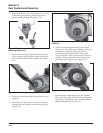
5.26
Section 5
Fuel System and Governor
Figure 5-57. Installing Float Assembly.
14. Hold the carburetor body so the float assembly
hangs vertically and rests lightly against the fuel
inlet needle. The inlet needle should be fully
seated but the center pin of the needle (on
retainer clip end) should not be depressed. Check
the float height adjustment.
NOTE: The inlet needle center pin is spring
loaded. Make sure the float rests against
the fuel inlet needle without depressing
the center pin.
15. The correct float height setting is 17 mm
(0.669 in.) ± 1.5 mm (0.059 in.), measured from
the float bottom to the body of the carburetor. See
Figure 5-58. Replace the float if the height is
different than the specified setting. Do not
attempt to adjust by bending float tab.
Figure 5-56. Float and Inlet Needle Details.
13. Install the float and inlet needle down into the
seat and carburetor body. Install the new pivot
pinthrough the float hinge and secure with the
new retaining screw. See Figure 5-57.
Figure 5-54. Installing Main Nozzles and Main Jets.
9. Make sure the O-Ring near the bottom of each
slow jet is new, or in good condition. Align and
insert the two slow jets into the top of carburetor.
See Figure 5-53.
10. Install the large flat retaining washer and secure
with the mounting screw, attaching the ground
lead if originally secured by the screw.
11. Install the new idle speed (RPM) adjustment
screw and spring onto the carburetor. Thread in
until 3 or 4 threads are exposed, as an initial
adjustment. See Figure 5-55.
Nozzle End with Two
Shoulders (Out/Down)
Main Jets
Figure 5-55. Installing Idle Speed Adjusting Screw
and Spring.
12. Attach the inlet needle to the plastic tang of the
float with the wire clip. The formed 90° lip
should point up, with the needle valve hanging
down. See Figure 5-56.


















